S Important Safety Notes
Please observe the following to ensure the telephone can be operated reliably:
S Please read this operating instruction manual thoroughly and observe the information contained when using the equipment.
S Place the telephone on a non−slip base and lay the connection cables so that they cannot be the source of an accident.
S Do not expose the equipment to extreme temperatures or humid conditions and protect it from direct sunlight and dusty conditions.
S Only clean the equipment with a soft, moist cloth. Never use any solvents or aggressive cleaning agents.
S Only connect approved accessories.
S Never open the equipment. Opening the equipment exposes the person to the risk of an electric shock. The terms of guarantee are also
annulled.
S Repairs to defect equipment may only be carried out by service centres authorised by the sales outlet.
S Exemption From Liability
We cannot guarantee that the information which relates to the technical properties of the product or to the product itself contained in this document is
correct. The product and its accessories described in this document are subject to constant improvement and further development. For this reason, we
reserve the right to modify components, accessories, technical specifications and related documentation of the product described herein at any time
without notice.
S Intended Use
The telephone is suitable for telephoning within a public telephone network system. Any other use is considered unintended use.
Unauthorised modifications or reconstruction not described in this manual are not permitted.
S Information on Disposal
The implementation of European law in national laws and directives obliges you to dispose of consumable goods appropriately.
This serves to protect both persons and the environment. The adjacent symbol indicates that electrical and
electronic apparatus no longer required must be disposed of separate from domestic waste.
Packaging materials must be disposed of according to local regulations.
S Installation
Package contents
The telephone package contains a receiver base, a handset with helix cable, a telephone line and this operating instruction manual.
Please check the contents of the package carefully. If anything is missing or shows signs of transport damage, do NOT put the telephone into service!
In such a case, contact your sales outlet, with the purchase receipt to hand, or the OLYMPIA Service Centre directly.
Note: Keep the equipment packaging so that it can be used to prevent equipment damage in the event of future transport.
Positioning the telephone
Position the telephone equipment in an easily accessible location. Ensure that it is set down on a stable, level, non−slip surface. In addition, ensure that
the equipment is positioned where all the necessary cables can be laid in such a way that nobody can trip over them. Do not place the telephone in the
direct vicinity of other electrical apparatus, such as microwave ovens, PCs or hi−fi equipment, for example.
Caution: Do not expose the telephone to direct sunlight. Protect the telephone from getting wet. The equipment must not be set
up in rooms in which condensation, corrosive vapours or high concentrations of dust develop and accumulate (e.g. cellar
rooms, garages or winter gardens). The ambient temperature must be between 0 °C and 40 °C.
Corded Telephone 4101
R
Setting the local code and area code (function is dependent on conventional telephone operator or PABX system!)
1. Press the J button. [ SET 12345678 ] appears in the display.
2. Press the 6 button. [ 1−LoC 2−oL ] appears in the display.
3. Press the 1 button. [ Loc −−−−−−−−− ] appears in the display.
4. Use the digit keys to set the code (up to 8 digits) and confirm the entry by pressing the J button.
5. Press the 2 button. [ out off ] appears in the display.
6. Use the digit keys to set the code (up to 8 digits) and confirm the entry by pressing the J button.
7. Use the / buttons to switch the function off again [ out off ].
8. Press the J button. The setting is saved.
9. Press the F button to conclude the setting.
Note: For further information, please contact your telephone service provider or PABX system manufacturer.
Setting the brightness
1. Press the J button. [ SET 12345678 ] appears in the display.
2. Press the 7 button. [ Lcd con 5 ] appears in the display.
3. Use the / buttons to set the required brightness from Level 1 to Level 5. Default setting = Level 5
4. Press the J button. The setting is saved.
5. Press the F button to conclude the setting.
S Operating the Telephone
Taking calls
1. The telephone rings when a call is received. The caller’s number appears in the display if this information is transmitted by the caller and your
telephone service provider has activated the function. If the caller number transmission function is suppressed or defect, [ − − − P − − − ] appears in
the display.
2. Lift the receiver from the receiver base and carry out the conversation.
3. To end a call, replace the receiver in the receiver base.
Making calls
1. Take the receiver from the receiver base.
2. Enter the phone number to be dialled using the digit keys.
Note: The current talk time appears in the display after about 6 seconds.
3. Carry out the conversation when the person called takes the call.
4. To end a call, replace the receiver in the receiver base.
Redialling
The phone number last dialled is saved in the telephone. If you want to call this number, you need not enter it with the digit keys again.
1. Take the receiver from the receiver base.
2. Press the E button. The last number dialled is redialled.
Or
3. Press the I button. Open the redialling list.
4. Press G or H. The list entries appear in the display in succession.
5. When the phone number required appears in the display, press the K button. The number is dialled.
6. Carry out the conversation when the person called takes the call.
7. To end a call, replace the receiver in the receiver base.
Saving one−touch dialling numbers
Phone numbers can be assigned to the A and B buttons which are subsequently dialled by pressing the respective button once.
1. Lift the receiver from the receiver base and keep the on−hook contact pressed.
2. Use the digit keys to enter the required number.
3. Press and hold the A or B button until SAVE appears in the display.
Direct dialling
1. Take the receiver from the receiver base.
2. Press the A or B button. The number is dialled.
3. Carry out the conversation when the person called takes the call.
4. To end a call, replace the receiver in the receiver base.
Putting a call on hold
1. Press the C button during a call and place the receiver in the receiver base.
2. The call is put on hold and the caller hears a melody.
3. To resume the call, simply lift the receiver from the receiver base.
Connecting the telephone
Connect the plug on the helix cable in the bottom socket (2) in the receiver base and the other end in the socket in the receiver.
Connect the plugs on the telephone line to the socket (1) in the receiver base and
socket labelled F in your telephone connection socket.
The telephone is now ready to operate.
Wall mounting
Two screws are required to install the base on a wall.
They must be mounted vertically, one above the other, 85 mm apart.
Leave about 2 mm of the screws projecting out of the wall.
Guide the holes in the receiver base over the screws and then slide the base down.
Caution: Select a suitable location for the installation.
Ensure there are no concealed cables or pipes where the holes are drilled.
Slide the receiver latch (inside of the receiver base) out upwards.
Turn the latch 180 degrees and insert it back in. The handset can now be hooked in.
S Operating Elements and Indicators
1. Earpiece
2. On−hook contact
3. M Volume setting
4. C Hold call
5. Digit keys
6. F Delete
7. E Redialling / Dialling pause
8. Microphone
9. D button (Flash)
10. AB One−touch dialling keys
11. H Scroll downwards
12. K Callback
13. I Open redialling / calls list
14. G Scroll upwards
15. J Menu / Confirm
16. Display
1
2
85 mm
1
2
4
5
6
7
8
9
10
11
12
13
14
15
16
3
S Settings
In general: Take the receiver from the receiver base. Press the on−hook contact (2) down with your finger and keep it pressed while making the
settings. Only release the on−hook contact and replace the receiver after all the settings have been programmed.
Setting the date and time
1. Press the J button. [ SET 12345678 ] appears in the display.
2. Press the 1 button. [ 1−dATE 2−CL ] appears in the display.
3. Press the 1 button.
4. Use the digit keys to set the required date and confirm the entry by pressing the J button.
Example: 110331 = 31.03.2011
5. Press the 2 button.
6. Use the digit keys to set the required time and confirm the entry by pressing the J button.
7. Press the F button to conclude the setting.
Setting the Flash time and pulse/tone dialling mode
1. Press the J button. [ SET 12345678 ] appears in the display.
2. Press the 5 button. [ 1−F 2−PT 3−d ] appears in the display.
3. Press the 1 button. [ FLASH 600 ] appears in the display.
4. Use the / buttons to set the required Flash time from 90 ms to 1000 ms.
5. Press the J button. The setting is saved.
6. Press the 2 button. [ PT TonE ] appears in the display.
7. Use the / buttons to select between PULSE and TONE. Default setting = TONE
8. Press the J button. The setting is saved.
9. Press the F button to conclude the setting.
F
S CLIP Operations
All incoming calls/phone numbers are stored in the CLIP memory.
Up to 50 entries are saved. You can scroll through the CLIP memory entries and call or delete the numbers stored.
Note: If calls are stored in the CLIP memory which were received but not taken, the last phone number received appears in the display.
Viewing the CLIP memory
1. Press G or H. The entries in the CLIP memory are displayed one after the other.
Dialling numbers stored in the CLIP memory
1. Press G or H. The entries in the CLIP memory are displayed one after the other.
2. When the phone number required appears in the display, press the K button. The number is dialled.
3. Carry out the conversation when the person called takes the call.
4. To end a call, replace the receiver in the receiver base.
Deleting an entry from the CLIP memory
1. Press G or H. The entries in the CLIP memory are displayed one after the other.
2. When the phone number required appears in the display, press the F button. The number is deleted from the CLIP memory.
Note: Deleted entries cannot be restored!
Deleting all entries from the CLIP memory
1. Press G or H. The entries in the CLIP memory are displayed one after the other.
2. When a phone number appears, press and hold the F button.
3. All the entries are deleted from the CLIP memory.
Note: Deleted entries cannot be restored!
S Entering a Dialling Pause (P)
If the telephone is connected to a PABX, it may be necessary to enter a dialling pause, e.g. to wait for an outside line. After entering the digit, e.g. 0 for an
outside line, press the E button. [ 0P......... ] appears in the display.
S Special Buttons
The D button, # button, * button and button can be used when the equipment is connected to a PABX system and in connection with
the T−Net functions offered by DEUTSCHE TELEKOM.
Note: For further information, please contact your telephone service provider or PABX system manufacturer.
S If the Telephone Does Not Work Properly
1. Check that the telephone has been connected properly. Refer to Section Installation"/"Connecting the telephone".
2. Ensure that the services you want to use have been enabled for your telephone connection. Please contact your telephone network provider for
more details.
3. Disconnect the telephone line plug from socket F of the telephone connection socket.
4. Wait for approx. one minute.
5. Connect the telephone line plug in socket F of the telephone connection socket.
6. If the telephone still does not work properly, contact your sales outlet, taking the sales receipt with you, or the OLYMPIA Service Center.
S Guarantee
Dear Customer,
We are very pleased that you have decided to buy this product. In case the equipment is defective, return it together with the purchase receipt and original
packaging to the point−of−sale.
S Technical Modifications
This operating instruction manual serves purely for information purposes. Its content is not part of any contract of sale.
All the data relates to nominal values. The equipment and options described may differ from country to country according to national requirements.
All rights reserved.
Conformity of the telephone with the applicable EU directives is
confirmed by the CE symbol.
The corresponding Declaration of Conformity is enclosed in the
packaging as a supplementary sheet.
25.03.2011 en/en

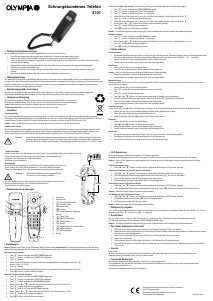


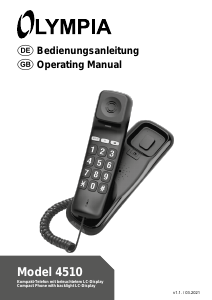
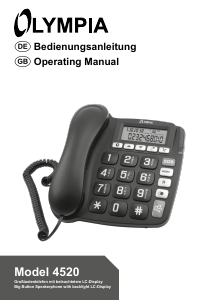

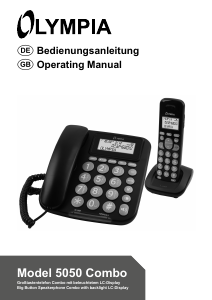
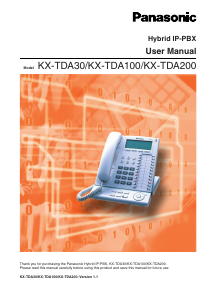

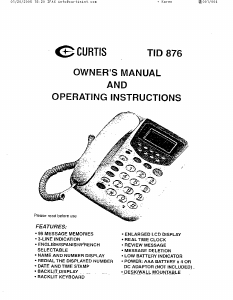

Praat mee over dit product
Laat hier weten wat jij vindt van de Olympia 4101 Telefoon. Als je een vraag hebt, lees dan eerst zorgvuldig de handleiding door. Een handleiding aanvragen kan via ons contactformulier.